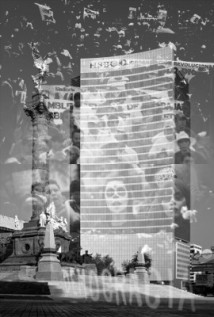Since the publication of the updated paperback edition of my book Revolution and State in Modern Mexico: The Political Economy of Uneven Development, the organisation Academic Trailers have put together this great feature on the book. The short YouTube video captures some of the essential features of the book in a novel and highly accessible way.
A central proposition of the book is that the conditioning situation of uneven and combined development on a world scale — as the geographical expression of the contradictions of capitalism — shapes the spatial, territorial, and scalar configuration of state power. However, although shaped by the condition of uneven and combined development, it is also the balance of class forces within state spaces that alters the developmental trajectory and spatial form of statehood through emergent passive revolutionary class strategies defining the rise of a state in capitalist society.
 The crucial element in passive revolution is the statifying tendency to reorganise or restructure the geographies of capital accumulation. This means that the state form becomes the dominant site, generator, and product of spatial projects in attempting to maintain the relationship of ruler–ruled and the incoherence of popular initiatives from below. My argument leads to the outlook that such processes across Latin America will clearly be different across state forms. Yet the condition of passive revolution does provide certain clues to the diversity of Latin American history and thus forms of transition to capitalist modernity within the region and, especially, in relation to spaces of state power in Mexico. Hence my argument that the Mexican Revolution (1910–1920) stands as one of the links in a chain of passive revolutions called forth by capitalist modernity in Latin America. My aim, then, in Revolution and State in Modern Mexico is to demonstrate how specific processes of passive revolution capture the territorial, class, and spatial relations of socially uneven and combined development in Mexico at the state level but also across various scales.
The crucial element in passive revolution is the statifying tendency to reorganise or restructure the geographies of capital accumulation. This means that the state form becomes the dominant site, generator, and product of spatial projects in attempting to maintain the relationship of ruler–ruled and the incoherence of popular initiatives from below. My argument leads to the outlook that such processes across Latin America will clearly be different across state forms. Yet the condition of passive revolution does provide certain clues to the diversity of Latin American history and thus forms of transition to capitalist modernity within the region and, especially, in relation to spaces of state power in Mexico. Hence my argument that the Mexican Revolution (1910–1920) stands as one of the links in a chain of passive revolutions called forth by capitalist modernity in Latin America. My aim, then, in Revolution and State in Modern Mexico is to demonstrate how specific processes of passive revolution capture the territorial, class, and spatial relations of socially uneven and combined development in Mexico at the state level but also across various scales.
The new lengthy epilogue to the paperback edition engages with some of these theoretical issues that have sprung forth within debates in Latin America on passive revolution since the publication of my book, not least engaging with the work of Enrique Semo. Also, I sketch some of the dominant contemporary territorial and scalar geographies of passive revolution and forms of resistance shaping the state spatial restructuring of Mexico under capitalism. These include the war on drugs, the so-called democratic transition since the election of Enrique Peña Nieto, and the enduring relevance of the Ejército Zapatista de Liberación Nacional (EZLN) in commanding counter-spaces of resistance.





























No comments yet